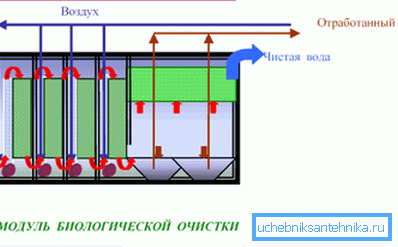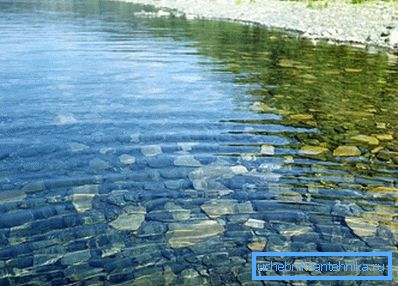Modern bio sewage for a country house: features of the
In this article we will talk about what constitutes bio-sewage in a private house and how it functions. The topic of the article is not accidental, since the operation of a country house or a plot is often hampered by the absence of the possibility of connecting to a centralized sewer system for drainage.

Someone in this situation is enough to build a cesspool, but if you own a full-fledged country house, you cannot do it alone.

In that case, when there is a need for waste disposal, but there is no possibility of connecting to the main pipeline, a specialized system is being built at the site, which allows for effective deep sewage treatment. Buildings of this type are distinguished by a lower cost of operation and maintenance compared to the cost of using and maintaining a centralized sewage system.
A wide range of biological wastewater treatment systems is currently on the market. Implemented solutions are characterized by different performance, for example, large modifications allow to serve more than a hundred users at a time.
Features of operation

Bioremediation plants operate on the principle of a series of physical and biochemical processes, during which the waste is decomposed into separate fractions and completely recycled. As a result, the liquid medium at the outlet does not represent an environmental hazard to the environment.
It would seem that bio-sewage works also as a normal septic tank of a filtration field, but at the same time it costs a little more. Why overpay? In fact, the system of biocoupling arranged an order of magnitude more difficult than a conventional septic tank.
In addition, they ensure sedimentation, their purification by means of microorganisms and the subsequent separation of the purified liquid medium from microorganisms and algae.
The work of a conventional septic tank is similar to the functioning of bio-sewage, with the difference that in the septic tank the separation of microorganisms does not occur after the cleaning. Therefore, the filtration system of the usual septic tank is periodically clogged and requires cleaning, which is not the case with full-fledged systems for the biological disposal of sewage.
Design features

Installations of biological sewage treatment are completely hermetic constructions made of polymeric materials. The degree of purification of wastewater in such installations on average reaches 98%.
Important: Of great importance in the operation of such equipment is the tightness of all structural elements in the treatment plant. In case of violation of tightness, there is leakage of sewage and, as a result, pollution of groundwater.

The main structural elements necessary for the full functioning of bio-sewage is a septic tank, biofilters and a collection well.
Let us consider in more detail how each of the above elements functions.
- The septic tank is used to retain and precipitate heavy fractions suspended in a liquid medium.. This device is a three-chamber tank through which water passes.
With the passage of each of the three chambers, the flow of waste water slows down and gravitational sedimentation of particles occurs. The precipitated particles gradually accumulate, and therefore, twice a year it is advisable to pump them out with an ashenizator machine.
- Biofilters are cassette type devices through which sewage passes and undergo anaerobic purification by microorganisms..
As they are used, the filters are washed. The bioactivator is added monthly in an amount proportional to the volume of the septic tank. It is in biofilters that recycled water is clarified and odor is removed from it.
- A collection well is used to discharge treated wastewater into ground drainage or stormwater.
The advantages of using modern bio-sewage

Modern biological wastewater treatment plants are high-tech equipment, characterized by many characteristic advantages, including:
- Guaranteed high degree of purification (at least 95%), which allows you to divert the processed liquid into adjacent water bodies without harming the ecosystem.
- Simplicity and low cost of installation, since there is no need to build protective structures around the system.
- The absence of moving parts and, as a result, the reliability and durability of all structural elements.
- A simple instruction of maintenance, as for the proper functioning of the system, it is enough to pump out the precipitated particles in a timely manner and drain the excess active sludge. In addition, a compressor diaphragm needs to be replaced every two years, which can be done by hand.
- Tightness of the case and, as a result, lack of negative impact on the environment. Tightness is achieved through the use of special welding.
- High degree of system security from a wide range of operational problems, including long-term effects of household chemicals, instantaneous discharges, irregular use, large volumes of wastewater, etc.
- Comfortable operation due to silent operation and due to the absence of unpleasant odors.
- Cost-effective use of equipment due to low power consumption of no more than 60W (installation, designed for servicing 10 users).
- Environmentally friendly construction due to the use of integrated foam polypropylene as industrial materials. This material, along with strength, resistance to corrosion and insulating properties, is distinguished by biological inertness.
- Reliability and operational predictability of the structure due to the use of high-strength pneumatic valves, as well as compressors and electronic components with a long service life (at least 15 years).
- After treatment with bacteria, fecal wastewater is processed into valuable fertilizers and water rich in trace elements. This is a very important advantage if there is a garden plot near a country house.
Purified water at the outlet of the sewer can be used for irrigation without fear of any negative consequences.
Important: Despite the complete tightness and isolation of bio-sewage, it should be located no closer than 15 meters to a well or water well.
Reasons for choosing biological treatment systems

- Lack of serious placement requirements. Often, old country houses are designed and built in such a way that a cesspool is used instead of a full sewage system. But, even with such unsuccessful planning, the house can be equipped with a complete wastewater treatment system.
- Autonomous mode of operation. There is a biological cleaning system, you use it, but remember it a couple of times a year when you need to clean and rinse filters or replace certain consumables.
- Complete stealth. Without knowing where the stand-alone wastewater treatment plant is located, you are unlikely to find it on the site. The recessed structure will not give its location or terrain, or odors.
Conclusion
Now you know what bio sewage is and what are the advantages of using it.
If you have any questions, the answers to them can be found by watching the video in this article.